
HMS Mildura was a Pearl-class cruiser built for the Royal Navy in the late 1880s. Originally named HMS Pelorus, she was renamed after an Australian town in April 1890. Per the Imperial Defense Act of 1887, she served primarily in Australian waters.
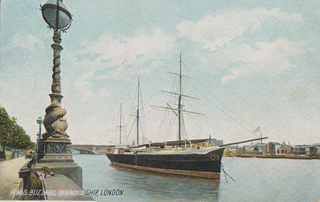
HMS Buzzard was a Nymphe-class composite screw sloop and the fourth ship of the Royal Navy to bear the name.

HMS Cormorant was an Osprey-class sloop launched at Chatham on 12 September 1877 and later the receiving ship at Gibraltar. She was renamed Rooke in 1946 and broken up in 1949.

HMS Niger was originally slated to be built as a Sampson designed sloop; however, she was ordered as a First-Class sloop with screw propulsion on 20 February 1845 to be built at Woolwich Dockyard, along the design developed by Oliver Lang and with a hull like the Basilisk designed paddle sloops. Her armament and engine were to be like the Encounter Design building at Pembroke. A second vessel (Florentia) was ordered on 26 March 1846 but after her keel was laid at Pembroke Dockyard, her construction was suspended on 6 October 1846 then cancelled three years later, on 22 May 1849. Niger She conducted important propulsion trials, finally proving the superiority of screw propulsion and served in West Africa, the Crimea, China, the East Indies and Australia. She took part in the New Zealand wars in 1860 and was sold for breaking in 1869.

HMS Penguin was an Osprey-class sloop. Launched in 1876, Penguin was operated by the Royal Navy from 1877 to 1881, then from 1886 to 1889. After being converted to a survey vessel, Penguin was recommissioned in 1890, and operated until 1908, when she was demasted and transferred to the Australian Commonwealth Naval Forces for use as a depot and training ship in Sydney Harbour. After this force became the Royal Australian Navy, the sloop was commissioned as HMAS Penguin in 1913. Penguin remained in naval service until 1924, when she was sold off and converted into a floating crane. The vessel survived until 1960, when she was broken up and burnt.

HMS Challenger was a second-class protected cruiser of the Challenger-class of the Royal Navy.
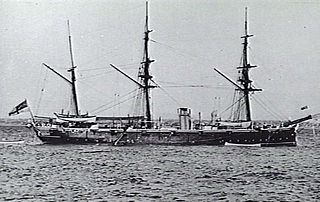
HMS Pylades was a Satellite-class composite screw sloop of the Royal Navy, built at Sheerness Dockyard and launched on 5 November 1884. She was later reclassified as a corvette and was the last corvette built for the Royal Navy until the Second World War.

HMS Royalist was a Satellite-class composite screw sloop of the Royal Navy, built in 1883 and hulked as a depot ship in 1900. She was renamed Colleen in 1913, transferred to the Irish Free State in 1923 and broken up in 1950.

HMS Torch was an Alert-class sloop of the Royal Navy, built at Sheerness Dockyard and launched in 1894. She served in Australia and New Zealand and was transferred to New Zealand as a training ship in 1917, being renamed HMS Firebrand at the same time. She was sold in 1920 and converted to a refrigerated ship with the new name Rama. She ran aground in the Chatham Islands in 1924 and was abandoned.

HMS Espiegle was a Doterel-class sloop of the Royal Navy, built at the Devonport Dockyard and launched on 3 August 1880.

HMS Danae was an Eclipse-class sloop of the Royal Navy, built at the Portsmouth Dockyard and launched on 21 May 1867.
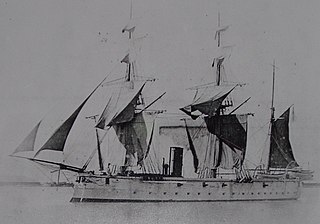
HMS Nymphe was an Amazon-class sloop, of the Royal Navy, built at the Deptford Dockyard and launched on 24 November 1866. She served in the East Indies and Australia, and was sold in 1884.
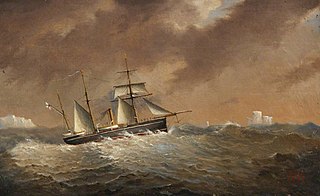
HMS Goldfinch was a Redbreast-class gunboat of the Royal Navy, built at Sheerness Dockyard and launched on 18 May 1889.

HMS Cambrian was a second-class protected cruiser, of the Royal Navy, built at the Pembroke Dockyard and launched on 30 January 1893. She was the last flagship of the Australia Station.

HMS Ringdove was a Redbreast-class gunboat of the Royal Navy, built at Devonport Dockyard and launched on 30 April 1889.

HMS Lizard was a Bramble-class screw gunboat of the Royal Navy, built by Harland & Wolff, Belfast and launched on 27 November 1886.

HMS Phoebe was a Pearl-class cruiser of the Royal Navy, in service from the early 1890s until 1906.

HMS Mutine was a Condor-class sloop of the Royal Navy. Mutine was launched on 1 March 1900. While being delivered from Birkenhead to Portsmouth an accident in Mutine's boiler rooms caused some loss of life and gave her a name as an unlucky ship before her career even began. She served on the China Station, then the Australia Station between December 1903 and February 1905 and later became a survey ship, surviving until 1932 as a Royal Naval Volunteer Reserve drill ship, the last of her class to be sold.
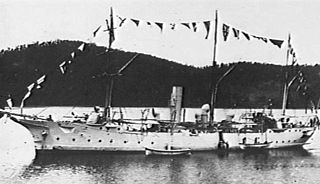
HMS Cadmus was a Cadmus-class sloop of the Royal Navy. She was launched at Sheerness in 1903, spent her entire career in the Far East and was sold at Hong Kong in 1921.

HMS Caroline was a Satellite-class composite screw sloop of the Royal Navy, built at Sheerness Dockyard, fitted with Maudslay, Sons and Field machinery and launched on 25 November 1882. She was later reclassified as a corvette.




















